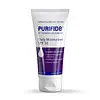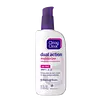What's inside
What's inside
 Key Ingredients
Key Ingredients

 Benefits
Benefits

 Concerns
Concerns

 Ingredients Side-by-side
Ingredients Side-by-side

Water
Skin ConditioningOctocrylene
UV AbsorberIsopropyl Lauroyl Sarcosinate
Skin ConditioningGlycerin
HumectantEthylhexyl Salicylate
UV AbsorberDimethicone
EmollientButyl Methoxydibenzoylmethane
UV AbsorberDiisopropyl Sebacate
EmollientSilica
AbrasivePolymethyl Methacrylate
Sucrose Tristearate
EmollientAluminum Starch Octenylsuccinate
AbsorbentPentylene Glycol
Skin ConditioningPolysorbate 61
EmulsifyingAllantoin
Skin ConditioningCaprylyl Glycol
EmollientCarbomer
Emulsion StabilisingDimethiconol
EmollientDisodium EDTA
Glycyrrhetinic Acid
Skin ConditioningHydroxypalmitoyl Sphinganine
Skin ConditioningPanthenol
Skin ConditioningPhenoxyethanol
PreservativePotassium Sorbate
PreservativeSodium Stearoyl Glutamate
CleansingTocopheryl Acetate
AntioxidantTriethanolamine
BufferingXanthan Gum
EmulsifyingZinc Gluconate
Skin ConditioningWater, Octocrylene, Isopropyl Lauroyl Sarcosinate, Glycerin, Ethylhexyl Salicylate, Dimethicone, Butyl Methoxydibenzoylmethane, Diisopropyl Sebacate, Silica, Polymethyl Methacrylate, Sucrose Tristearate, Aluminum Starch Octenylsuccinate, Pentylene Glycol, Polysorbate 61, Allantoin, Caprylyl Glycol, Carbomer, Dimethiconol, Disodium EDTA, Glycyrrhetinic Acid, Hydroxypalmitoyl Sphinganine, Panthenol, Phenoxyethanol, Potassium Sorbate, Sodium Stearoyl Glutamate, Tocopheryl Acetate, Triethanolamine, Xanthan Gum, Zinc Gluconate
Water
Skin ConditioningPropylene Glycol
HumectantC12-15 Alkyl Benzoate
AntimicrobialCetyl Alcohol
EmollientCyclomethicone
EmollientStearyl Alcohol
EmollientMenthyl Lactate
MaskingPropylene Glycol Isostearate
Skin ConditioningStearic Acid
CleansingGlyceryl Stearate
EmollientSalicylic Acid
MaskingPEG-100 Stearate
Sodium Hydroxide
BufferingDimethicone
EmollientSodium Isostearoyl Lactylate
EmulsifyingAcrylates/C10-30 Alkyl Acrylate Crosspolymer
Emulsion StabilisingCarbomer
Emulsion StabilisingDisodium EDTA
Phenoxyethanol
PreservativeMethylparaben
PreservativeEthylparaben
PreservativePropylparaben
PreservativeButylparaben
MaskingIsobutylparaben
AntimicrobialWater, Propylene Glycol, C12-15 Alkyl Benzoate, Cetyl Alcohol, Cyclomethicone, Stearyl Alcohol, Menthyl Lactate, Propylene Glycol Isostearate, Stearic Acid, Glyceryl Stearate, Salicylic Acid, PEG-100 Stearate, Sodium Hydroxide, Dimethicone, Sodium Isostearoyl Lactylate, Acrylates/C10-30 Alkyl Acrylate Crosspolymer, Carbomer, Disodium EDTA, Phenoxyethanol, Methylparaben, Ethylparaben, Propylparaben, Butylparaben, Isobutylparaben
Ingredients Explained
These ingredients are found in both products.
Ingredients higher up in an ingredient list are typically present in a larger amount.
Carbomer is a polymer of acrylic acid. Its main role is to create a gel consistency.
A high amount of carbomer can cause pilling or balling up of products. Don't worry, most products contain 1% or less of carbomer.
Dimethicone is a type of synthetic silicone created from natural materials such as quartz.
What it does:
Dimethicone comes in different viscosities:
Depending on the viscosity, dimethicone has different properties.
Ingredients lists don't always show which type is used, so we recommend reaching out to the brand if you have questions about the viscosity.
This ingredient is unlikely to cause irritation because it does not get absorbed into skin. However, people with silicone allergies should be careful about using this ingredient.
Note: Dimethicone may contribute to pilling. This is because it is not oil or water soluble, so pilling may occur when layered with products. When mixed with heavy oils in a formula, the outcome is also quite greasy.
Learn more about DimethiconeDisodium EDTA plays a role in making products more stable by aiding other preservatives.
It is a chelating agent, meaning it neutralizes metal ions that may be found in a product.
Disodium EDTA is a salt of edetic acid and is found to be safe in cosmetic ingredients.
Learn more about Disodium EDTAPhenoxyethanol is a preservative that has germicide, antimicrobial, and aromatic properties. Studies show that phenoxyethanol can prevent microbial growth. By itself, it has a scent that is similar to that of a rose.
It's often used in formulations along with Caprylyl Glycol to preserve the shelf life of products.
Water. It's the most common cosmetic ingredient of all. You'll usually see it at the top of ingredient lists, meaning that it makes up the largest part of the product.
So why is it so popular? Water most often acts as a solvent - this means that it helps dissolve other ingredients into the formulation.
You'll also recognize water as that liquid we all need to stay alive. If you see this, drink a glass of water. Stay hydrated!
Learn more about Water